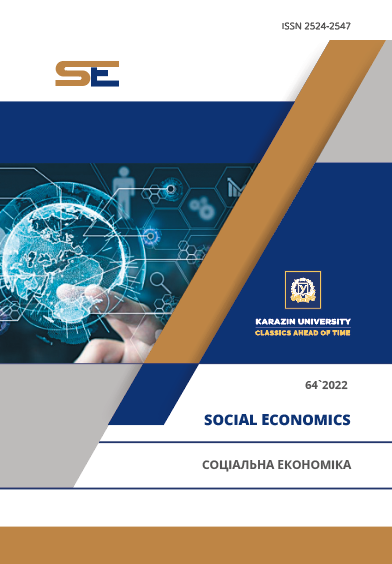ПРОБЛЕМИ СТИЛІВ НАВЧАННЯ В КОНТЕКСТІ УСПІШНОСТІ СТУДЕНТА В ПЕРЕВЕРНУТОМУ КЛАСІ
Анотація
Багато дослідників зазначають, що в контексті цифрового переходу, який швидко впроваджує всі сектори суспільства, перевернута класна кімната є необхідним методом впровадження навчальної програми, орієнтованої на результати, на вищому рівні для підготовки майбутніх професіоналів, які відповідають потребам роботодавців. Тому ми вважаємо, що основою успішного впровадження навчання є, по-перше, діагностика стилю навчання учня, по-друге, визначення результату навчання учня в ХХІ столітті на основі 4Cs; будучи досвідченими комунікаторами, творцями, критичними мислителями та співавторами. Таким чином, 41 студент другого курсу з двох різних груп, які вивчають бізнес-адміністрування в університеті Мандах, були обрані невипадковим чином і розділені на три групи на основі їхніх стилів навчання. Виконання завдань учнів EFL оцінюється за критеріями (інформація та відкриття, дизайн ідеї, інновація, виступ з усною презентацією, участь у бесідах та дискусіях) на основі принципів 4Cs як змінних. Згідно з даними, домінуючими є критичне мислення візуальних учнів, креативність кінестетичних учнів та комунікативні навички аудіо учнів. Загалом ми очікуємо, що потреба в нових педагогічних підходах у класах англійської мови для вдосконалення основних навичок учнів у 21 столітті, підхід до перевернутого навчання, коли пряме навчання під час уроків і домашнє завдання змінюються, нещодавно привернули значну увагу багатьох мов вчителі, вихователі та дослідники. У сучасному академічному світі одним із середовищ навчання, які отримали визнання, є система управління навчанням і викладанням. Система керування навчанням, також відома як віртуальне навчальне середовище, система керування курсами або навчальна платформа, — це набір програмних інструментів і веб-технологій, які підтримують організацію, адміністрування, надання, моніторинг і управління онлайн-освітою та навчанням. програми, а також оцінювання окремих процесів навчання.
Завантаження
Посилання
Amresh, A., Carberry, A. R., & Femiani, J. (2013). Evaluating the effectiveness of flipped classrooms for teaching cs1. 2013 IEEE Frontiers in Education Conference (FIE), (pages. 733–735). doi: https://doi.org/10.1109/FIE.2013.6684923
Abbas Pourhossein Gilakjani, S. M. (2011). The Effect of Visual, Auditory, and Kinaesthetic Learning Styles on Language Teaching. Pinang, Malaysia.
Bergmann, J., & Sams, A. (2014). Flipped learning: Gateway to student engagement. International Society for Technology in Education. International Society for Technology in Education: Eugene, Oregon and Washington, DC, 2014.
Cohen, A. D. (2003). The learner’s side of foreign language learning: where do styles, strategies, and tasks meet? International Review of Applied Linguistics in Language Teaching, 41, 279-291. doi: https://doi.org/10.1515/iral.2003.013
Cooper, B. (2021). simpleK12. Retrieved from https://www.simplek12.com/learning-theories-strategies/4cs-21st-century-skills/.
Cunningham, U. (2016). Language pedagogy and non-transience in the flipped classroom. Journal of Open, Flexible and Distance Learning, 20 (1), 44-58.
Curry, L. (April, 1983). An Organisation of Learning Styles Theory and Constructs.
Diaz, C. (July, 1992). Multicultural Education for the 21 st century.
Mason, G. S., Shuman, T. R., & Cook, K. E. (2013). Comparing the Effectiveness of an Inverted Classroom to a Traditional Classroom in an Upper-Division Engineering Course. IEEE Transactions on Education, 56, 430–435. doi: https://doi.org/10.1109/te.2013.2249066
Gilakjani, A. P. (February, 2012). Visual, Auditory, Kinaesthetic Learning Styles and Their Impacts on English Language Teaching. Lahijan, Iran. doi: https://doi.org/10.5296/jse.v2i1.1007
Gulnaz, F. (2018 оны December). Learning Styles: Preferred Learning Choices and Behaviors of Saudi Male and Female EFL Learners. Saudi Arabia. doi: https://doi.org/10.22555/joeed.v5i2.1847
Halvorsen, A. (2018). 21st Century Skills and the “4Cs” in the English. Oregon.
DeSantis, J., Van Curen, R., Putsch, J., & Metzger, J. (2015). Do students learn more from a flip? an exploration of the efficacy of flipped and traditional lessons. Interactive Learning Research, 26, 39–63.
Moffett, J. & Mill, A. C. (2014). Evaluation of the flipped classroom approach in a veterinary professional skills course. Advances in medical education and practice, 5, 415. doi: https://doi.org/10.2147/amep.s70160
Ziegelmeier, L. B., & Topaz, C. M. (2015). Flipped calculus: A study of student performance and perceptions. PRIMUS, 25, 847–860. doi: https://doi.org/10.1080/10511970.2015.1031305
Bradford, M., Muntean, C., & Pathak, P. (2014). An analysis of flip-classroom pedagogy in first-year undergraduate mathematics for computing. Frontiers in Education Conference (FIE), (pages: 1–5). doi: https://doi.org/10.1109/fie.2014.7044072
Mehring, J. (2015). An exploratory study of the lived experiences of Japanese undergraduate EFL. Unpublished Doctoral Dissertation. Pepperdine University: Malibu. doi: https://doi.org/10.17759/jmfp.2015040208
Millsaps, J. (March 2019). Alo7love to learn. Retrieved from https://blog.alo7.com/esl-teaching-strategies-auditory-learners/.
Milman, N. B. (2012). The flipped classroom strategy: What is it and how can it best be used? Distance Learning, 9.
Nadezhda, P. (March 2013). ESP Teaching at the institutions of higher education in modern Russia: Problems and perspectives. Balakovo, Russia. doi: https://doi.org/10.2139/ssrn.2232203
Pardede, P. (February 2020). Integrating the 4Cs into EFL Integrated Skills Learning. Journal of English Teaching, 6 (1). doi: https://doi.org/10.33541/jet.v6i1.190
Parnrod, U. (February 2018). Relationships between Students' Learning Style and Their Academic Achievement for English Courses. Bangkok, Thailand.
Radhwan Hussein Ibrahim, D.-A. H. (2016). Assessment of visual, auditory, and kinesthetic learning style among undergraduate nursing students. doi: https://doi.org/10.14419/ijans.v5i1.5124
Saleh, D. S. (October 2019). 4Cs in the EFL Classroom.
Saleh, S. E. (October 2019). 21-century skills in the EFL classroom: Conceptions, Challenges and Implementation. Libya.
Sohaya, E. M. (2020). Blended Learning and 4Cs: Trends in the New Normal Life of Education, Globalization and the Next Decade. Medan, Indonesia. doi: https://doi.org/assehr.k.201124.019
Stone, B. B. (2012). Flip your classroom to increase active learning and student engagement. International Annual Conference on Distance Teaching & Learning, Madison.
Syofyan, R. (2018). The Impact of Visual, Auditory, and Kinesthetic Learning Styles on Economics. Padang, Indonesia. doi: https://doi.org/piceeba-18.2018.17
Tan Xin Yu, W. M. (September 2019). Integration of 21st Century Learning Skills (4C Elements) in Interventions to Improve English Writing Skill Among 3K Class Students. Malaysia. doi: https://doi.org/10.11114/ijce.v2i2.4498
Xu, W. (2011). Learning Styles and Their Implications in Learning and Teaching. China.
Zahra, R., & Mohsen, Sh. (2021). The Effect of Flipped Classroom on Iranian ESP Students’ Vocabulary. International Journal of Foreign Language Teaching & Research, 9.





